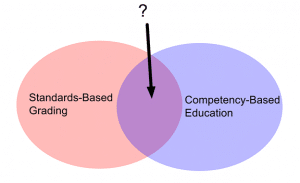What is the Difference between Standards-Based Grading (or Reporting) and Competency-Based Education?
CompetencyWorks Blog

Here in Iowa, competency-based education is gaining traction at the state and grassroots level. In fact, the Iowa Department of Education has launched a multi-year CBE collaborative. Needless to say, it’s an exciting time to be an educator in the Hawkeye State!
Meanwhile, a core group of Iowa schools have started to implement a standards-based grading philosophy in middle and high schools. Because of these two movements in our state, standards-based grading and competency-based education are often times incorrectly presented as synonymous practices. As a member of Iowa’s CBE task force and through my work as a district administrator in a system that has embraced standards-based grading K-12, I’ve been in a position to think about and discuss these two topics extensively. When area schools hear about our grading and reporting practices, we are often asked how our system relates to those working towards competency-based educational models. While many of the ideas overlap, I felt compelled to tease out these two education terms in order to honor their similarities and differences.
What is standards-based grading?
Standards-based grading “involves measuring students’ proficiency on well-defined course objectives.” (Tomlinson & McTighe, 2006). (Note: Standards-based reporting involves reporting these course objectives rather than letter grades at the end of each grading/reporting period.)
The visual below compares traditional grading with standards-based grading practices.
| Traditional Grading System | Standards-Based Grading System |
|---|---|
| 1. Based on assessment methods (quizzes, tests, homework, projects, etc.). One grade/entry is given per assessment. | 1. Based on learning goals and performance standards. One grade/entry is given per learning goal. |
| 2. Assessments are based on a percentage system. Criteria for success may be unclear. | 2. Standards are criterion or proficiency-based. Criteria and targets are made available to students ahead of time. |
| 3. Use an uncertain mix of assessment, achievement, effort, and behavior to determine the final grade. May use late penalties and extra credit. | 3. Measures achievement only OR separates achievement from effort/behavior. No penalties or extra credit given. |
| 4. Everything goes in the grade book – regardless of purpose. | 4. Selected assessments (tests, quizzes, projects, etc.) are used for grading purposes. |
| 5. Include every score, regardless of when it was collected. Assessments record the average – not the best – work. | 5. Emphasize the most recent evidence of learning when grading. |
Adapted from O’Connor K (2002). How to Grade for Learning: Linking grades to standards (2nd ed.). Thousand Oaks, CA: Corwin Press.
In our district, secondary teachers are required to abide by the following grading guidelines:
- Entries in the grade book that count towards the final grade will be limited to course or grade level standards.**
- Extra credit will not be given at any time.
- Students will be allowed multiple opportunities to demonstrate their understanding of classroom standards in various ways. Retakes and revisions will be allowed.
- Teachers will determine grade book entries by considering multiple points of data emphasizing the most recent data and provide evidence to support their determination.
- Students will be provided multiple opportunities to practice standards independently through homework or other class work. Practice assignments and activities will be consistent with classroom standards for the purpose of providing feedback. Practice assignments, including homework, will not be included as part of the final grade.
** Exceptions will be made for midterm and/or final summative assessments. These assessments, limited to no more than one per nine-week period, may be reported as a whole in the grade book.
Parents and teachers have commented positively after watching a short five-minute video explaining standards-based grading that was used to convey these ideas prior to our implementation dating back to the 2012-13 school year.
What is competency-based education?
Under a competency-based education system, “learners advance through content or earn credit based on demonstration of proficiency of competencies” rather than seat time. (Source: Iowa Department of Education CBE Pathways.)
With so many definitions of CBE available, I settled on principles of competency-based education from Iowa’s Guidelines for PK-12 Competency-Based Pathways as a reputable framework, because they were adapted from International Association for K-12 Online Learning (iNACOL). I’ve included the CBE Pathways principles and their descriptors below.
A. Students Advance upon Mastery
- Students advance to higher-level work upon demonstration of mastery of standards rather than according to age or seat time.
- Students are evaluated on performance and application.
- Students will master standards and earn credit or advance in content at their own pace.
- They will work through some standards more rapidly while taking more time to ensure mastery on others.
B. Explicit and Measurable Learning Objectives that Empower Students
- The relationship between student and teacher is fundamentally changed as students gain understanding of what working with standards requires and take ownership of learning, and as teachers provide the appropriate supports for learning.
- The unit of learning becomes modular.
- Learning expands beyond the classroom.
C. Assessment Is Meaningful and a Positive Learning Experience for Students
- Schools embrace a strong emphasis on formative assessment as the unit of learning becomes modular.
- Teachers collaborate to develop understanding of what is an adequate demonstration of proficiency.
- Teachers assess skills or concepts in multiple contexts and multiple ways.
- Attention is on student learning, not student grades.
- Summative assessments are adaptive and timely.
- Assessment rubrics are explicit in what students must be able to know and do to progress to the next level of study.
- Examples of student work that demonstrate skills development throughout a learning continuum help students understand their own progress.
D. Rapid, Differentiated Support for Students Who Fall Behind or Become Disengaged
- Educator capacity, and students’ own capacity to seek out help, will be enhanced by technology-enabled solutions that incorporate predictive analytic tools.
- Pacing matters. Although students will progress at their own speeds, students who are proceeding more slowly will need more help, and educators must provide high-quality interventions.
E. Learning Outcomes Emphasize Application and Creation of Knowledge
- Competencies will include the standards, concepts, and skills of the Iowa Core as well as the universal constructs (creativity, complex communication, collaboration, critical thinking, flexibility and adaptability, and productivity and accountability).
- Lifelong learning skills are designed around students needs, life experiences, and the skills needed for them to be ready for college, career, and citizenry.
- Expanded learning opportunities are created as opportunities for students to develop and apply skills as they are earning credit.

What are some ways in which standards-based grading and competency-based education are similar?
In both systems…
- Students learn specific standards or competencies based on a pre-determined rubric.
- Students take more ownership of their learning, because it (learning) is communicated rather than “Project 3” or “Worksheet 4-2.”
- Using assessments in formative ways is the norm rather than exception.
These two systems may be similar in some contexts. For example, learning outcomes could emphasize application and creation of knowledge in a classroom that uses a standards-based grading philosophy, but, by definition in a standards-based system, this may or may not be the case. Similarly, experiences could be designed around students’ needs and life experiences in a standards-based grading classroom, but it is not necessarily the norm.
What are some ways in which standards-based grading and competency-based education are different?
In a competency-based system…
- Students advance to higher-level work and can earn credit at their own pace. (In a building, district, or classroom using a standards-based grading philosophy, this is not necessarily the case. Students are likely required to complete x number of hours of seat time in order to earn credit for the course.)
- Learning expands beyond the classroom. This may or may not take place in a standards-based grading philosophy. For example, in a competency-based system, a student who learns a lot about woodworking over the summer may earn credit when he or she returns to school the next year. Similarly, students are encouraged to learn outside the classroom so that they can demonstrate competencies at their own, rapid rate.
- Teachers assess skills or concepts in multiple contexts and multiple ways. (This may or may not be the case in a standards-based grading classroom; however, it is non-negotiable in competency-based education.)
Summary
A standards-based grading (SBG) philosophy is similar, but not synonymous with, the idea of competency-based education (CBE). SBG is a way of thinking about grading and assessment that more clearly communicates with parents and students how well learners currently understand the course objectives/standards/competencies. CBE is a system in which students move from one level of learning to the next based on their understanding of pre-determined competencies without regard to seat time, days, or hours. A competency-based system may utilize a standards-based report card to communicate student learning; however, the two educational terms are not, by definition, the same.
Matt Townsley joined the Solon Community School District (Solon, IA) central office administrative team in 2010. Prior to his current role, he taught high school math for six years in the same district. Currently, Matt is pursuing a doctorate in school improvement at the University of West Georgia. One of his articles, “Redesigning Grading—Districtwide” was published in the December 2013 issue of Educational Leadership. He regularly presents at conferences and leads professional development on the topics of formative assessment and standards-based grading. He can be reached at @mctownsley on Twitter.